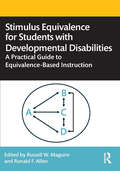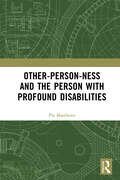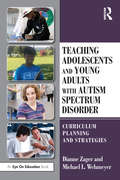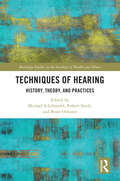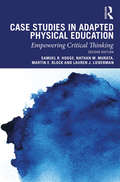- Table View
- List View
Steven the Snail: Targeting s Blends (Speech Bubbles 1)
by Melissa PalmerSteven is having a birthday party, but it’s a long journey to the party. Will me make it in time, and in one piece? This picture book targets /s/ blends, and is part of Speech Bubbles 1, a series of picture books that target specific speech sounds within the story. The series can be used for children receiving speech therapy, for children who have a speech sound delay/disorder, or simply as an activity for children’s speech sound development and/or phonological awareness. They are ideal for use by parents, teachers or caregivers. Bright pictures and a fun story create an engaging activity perfect for sound awareness. Please see other titles in the series for stories targeting other speech sounds.
Speech Bubbles 1 User Guide: Supporting Speech Sound Development in Children (Speech Bubbles 1)
by Melissa PalmerThis book is the supporting guide for Speech Bubbles 1,the first set in an exciting new series of picture books designed to be used by Speech Language Therapists/Pathologists, parents/caregivers, and teachers with children who have delayed or disordered speech sound development, children receiving speech therapy, or by those wanting to provide sound awareness activities for their children. This user guide contains notes for both professionals and caregivers, to support the use of one or all of the picture books in the series.
Who Bit My Tail?: Targeting the t Sound (Speech Bubbles 1)
by Melissa PalmerTiger wakes from a dream to find a big bite on his tail – but can he discover who is the culprit? This picture book targets the /t/ sound, and is part of Speech Bubbles 1, a series of picture books that target specific speech sounds within the story. The series can be used for children receiving speech therapy, for children who have a speech sound delay/disorder, or simply as an activity for children’s speech sound development and/or phonological awareness. They are ideal for use by parents, teachers or caregivers. Bright pictures and a fun story create an engaging activity perfect for sound awareness. Please see other titles in the series for stories targeting other speech sounds.
Ben the Bubble Bear: Targeting the b Sound (Speech Bubbles 1)
by Melissa PalmerBen the bear loves to blow bubbles, but what happens when he tries to blow the biggest bubble in the world? This picture book targets the /b/ sound, and is part of Speech Bubbles 1, a series of picture books that target specific speech sounds within the story. The series can be used for children receiving speech therapy, for children who have a speech sound delay/disorder, or simply as an activity for children’s speech sound development and/or phonological awareness. They are ideal for use by parents, teachers or caregivers. Bright pictures and a fun story create an engaging activity perfect for sound awareness. Please see other titles in the series for stories targeting other speech sounds.
Polly's Pink Paint: Targeting the p Sound (Speech Bubbles 1)
by Melissa PalmerPolly the pig loves pink – but her friends do not. Can they work it out? This picture book targets the /p/ sound, and is part of Speech Bubbles 1, a series of picture books that target specific speech sounds within the story. The series can be used for children receiving speech therapy, for children who have a speech sound delay/disorder, or simply as an activity for children’s speech sound development and/or phonological awareness. They are ideal for use by parents, teachers or caregivers. Bright pictures and a fun story create an engaging activity perfect for sound awareness. Please see other titles in the series for stories targeting other speech sounds.
Gus the Gulping Goat: Targeting the g Sound (Speech Bubbles 1)
by Melissa PalmerGus loves to gulp yoghurt, but he is not the only one. Has he met his match? This picture book targets the /g/ sound, and is part of Speech Bubbles 1, a series of picture books that target specific speech sounds within the story. The series can be used for children receiving speech therapy, for children who have a speech sound delay/disorder, or simply as an activity for children’s speech sound development and/or phonological awareness. They are ideal for use by parents, teachers or caregivers. Bright pictures and a fun story create an engaging activity perfect for sound awareness. Please see other titles in the series for stories targeting other speech sounds.
Crocodiles Can't Climb Trees: Targeting the k Sound (Speech Bubbles 1)
by Melissa PalmerLucas the Monkey loves to play soccer by the river, but he has a problem – Mr. Crocodile, who would love to make Lucas his dinner. This picture book targets the /k/ sound, and is part of Speech Bubbles 1, a series of picture books that target specific speech sounds within the story. The series can be used for children receiving speech therapy, for children who have a speech sound delay/disorder, or simply as an activity for children’s speech sound development and/or phonological awareness. They are ideal for use by parents, teachers or caregivers. Bright pictures and a fun story create an engaging activity perfect for sound awareness. Please see other titles in the series for stories targeting other speech sounds.
Where's Mummy Mouse?: Targeting the m Sound (Speech Bubbles 1)
by Melissa PalmerMolly mouse wakes to find her Mummy has vanished, so she sets off to find her – meeting some interesting creatures along the way. This picture book targets the /m/ sound, and is part of Speech Bubbles 1, a series of picture books that target specific speech sounds within the story. The series can be used for children receiving speech therapy, for children who have a speech sound delay/disorder, or simply as an activity for children’s speech sound development and/or phonological awareness. They are ideal for use by parents, teachers or caregivers. Bright pictures and a fun story create an engaging activity perfect for sound awareness. Please see other titles in the series for stories targeting other speech sounds.
A Bunny Called Noodle: Targeting the n Sound (Speech Bubbles 1)
by Melissa PalmerNoodle loves to jump in muddy puddles, and his friends don’t understand. Will he ever make a friend who accepts him? This picture book targets the /n/ sound, and is part of Speech Bubbles 1, a series of picture books that target specific speech sounds within the story. The series can be used for children receiving speech therapy, for children who have a speech sound delay/disorder, or simply as an activity for children’s speech sound development and/or phonological awareness. They are ideal for use by parents, teachers or caregivers. Bright pictures and a fun story create an engaging activity perfect for sound awareness. Please see other titles in the series for stories targeting other speech sounds.
Muffin the Fish: Targeting the f Sound (Speech Bubbles 1)
by Melissa PalmerMuffin is a quirky little fish full of fun ideas. What will he get up to next? This picture book targets the /f/ sound, and is part of Speech Bubbles 1, a series of picture books that target specific speech sounds within the story. The series can be used for children receiving speech therapy, for children who have a speech sound delay/disorder, or simply as an activity for children’s speech sound development and/or phonological awareness. They are ideal for use by parents, teachers or caregivers. Bright pictures and a fun story create an engaging activity perfect for sound awareness. Please see other titles in the series for stories targeting other speech sounds.
Sally's Sandcastles: Targeting the s Sound (Speech Bubbles 1)
by Melissa PalmerA day at the seaside sounds magical to Sally, who brings her bucket and spade for a sandcastle making adventure. This picture book targets the /s/ sound, and is part of Speech Bubbles 1, a series of picture books that target specific speech sounds within the story. The series can be used for children receiving speech therapy, for children who have a speech sound delay/disorder, or simply as an activity for children’s speech sound development and/or phonological awareness. They are ideal for use by parents, teachers or caregivers. Bright pictures and a fun story create an engaging activity perfect for sound awareness. Please see other titles in the series for stories targeting other speech sounds.
Steven the Snail: Targeting s Blends (Speech Bubbles 1)
by Melissa PalmerSteven is having a birthday party, but it’s a long journey to the party. Will me make it in time, and in one piece? This picture book targets /s/ blends, and is part of Speech Bubbles 1, a series of picture books that target specific speech sounds within the story. The series can be used for children receiving speech therapy, for children who have a speech sound delay/disorder, or simply as an activity for children’s speech sound development and/or phonological awareness. They are ideal for use by parents, teachers or caregivers. Bright pictures and a fun story create an engaging activity perfect for sound awareness. Please see other titles in the series for stories targeting other speech sounds.
Stimulus Equivalence for Students with Developmental Disabilities: A Practical Guide to Equivalence-Based Instruction
by W. Maguire Russell F. Allen RonaldStimulus Equivalence for Students with Developmental Disabilities provides a step-by-step program for converting lesson plans into equivalence-based instruction. Using language and tools accessible to both students and practitioners, chapters present the concept of equivalence-based instruction and include clear and concise procedural descriptions, as well as data sheets and PowerPoint slides, with replaceable stimuli, so that special educators and clinicians will be able to immediately implement this procedure to teach any academic skill. Written in engaging prose with an emphasis on practical application, this book is an essential resource for special educators and graduate students studying to become BCBAs and special educators.
Stimulus Equivalence for Students with Developmental Disabilities: A Practical Guide to Equivalence-Based Instruction
by Russell W. Maguire Ronald F. AllenStimulus Equivalence for Students with Developmental Disabilities provides a step-by-step program for converting lesson plans into equivalence-based instruction. Using language and tools accessible to both students and practitioners, chapters present the concept of equivalence-based instruction and include clear and concise procedural descriptions, as well as data sheets and PowerPoint slides, with replaceable stimuli, so that special educators and clinicians will be able to immediately implement this procedure to teach any academic skill. Written in engaging prose with an emphasis on practical application, this book is an essential resource for special educators and graduate students studying to become BCBAs and special educators.
Other-person-ness and the Person with Profound Disabilities
by Pia MatthewsMany people think that profound disability presents us with a real problem, often because it seems difficult to connect with someone who does not seem to think or act like us. Positioning profound disability in this way immediately sets up a ‘them’ and ‘us’, where the person with profound disability becomes the problematic ‘other’. Attempts to bridge the ‘them’ and ‘us’ risk reducing everyone to the same where disability is not taken seriously.In contrast to a ‘them’ and ‘us’, and negative connotations of the other found in the existentialist philosophies of writers like Sartre and Beauvoir, Pia Matthews argues for a return to a positive view of the other. One positive approach to the other, based on an ethics of relationship as championed by Levinas, seems to mitigate the other-ness of profound disability. However, this still makes the person with profound disability dependent on the ethical concern of the more powerful other. Instead, this book argues for return to a personalist philosophy of being offered by Mounier, Marcel, and Wojtyła, and deepened by participation, belonging, and the possibility of contributing to the good of all. This deepened philosophy of being gives a more solid foundation for people who are especially at the mercy of others. It will be of interest to all scholars and students of disability studies, philosophy and anthropology.
Other-person-ness and the Person with Profound Disabilities
by Pia MatthewsMany people think that profound disability presents us with a real problem, often because it seems difficult to connect with someone who does not seem to think or act like us. Positioning profound disability in this way immediately sets up a ‘them’ and ‘us’, where the person with profound disability becomes the problematic ‘other’. Attempts to bridge the ‘them’ and ‘us’ risk reducing everyone to the same where disability is not taken seriously.In contrast to a ‘them’ and ‘us’, and negative connotations of the other found in the existentialist philosophies of writers like Sartre and Beauvoir, Pia Matthews argues for a return to a positive view of the other. One positive approach to the other, based on an ethics of relationship as championed by Levinas, seems to mitigate the other-ness of profound disability. However, this still makes the person with profound disability dependent on the ethical concern of the more powerful other. Instead, this book argues for return to a personalist philosophy of being offered by Mounier, Marcel, and Wojtyła, and deepened by participation, belonging, and the possibility of contributing to the good of all. This deepened philosophy of being gives a more solid foundation for people who are especially at the mercy of others. It will be of interest to all scholars and students of disability studies, philosophy and anthropology.
Teaching Adolescents and Young Adults with Autism Spectrum Disorder: Curriculum Planning and Strategies
by Dianne Zager Michael L. WehmeyerTeaching Adolescents and Young Adults with Autism Spectrum Disorder supports teachers in preparing secondary students with autism spectrum disorder (ASD) to succeed in school, work and beyond. Focused on enabling students to successfully pursue further education and meaningful career paths, chapters incorporate person-centered, student-directed planning into instructional programming throughout the text. Featuring helpful vignettes to demonstrate concepts in action, curriculum areas address community living skills, academics, social communication and interaction, and career preparation. Grounded in current research and Universal Design for Learning practices, this guide is an essential resource for educators, therapists, and anyone seeking to create fluid, adaptable programs for students with autism spectrum disorders.
Speech Bubbles 1: Supporting Speech Sound Development in Children (Speech Bubbles 1)
by Melissa PalmerSpeech Bubbles 1 is the first set in an exciting new series of picture books designed to be used by Speech Language Therapists/Pathologists, parents/caregivers, and teachers with children who have delayed or disordered speech sound development, children receiving speech therapy, or by those wanting to provide sound awareness activities for their children. The set includes eleven picture books that each target a different speech sound within the story. The set is also accompanied by a user guide with notes for professionals and caregivers alike. Eleven different speech sounds have been chosen that are early developing sounds, or sounds commonly targeted in speech language therapy: /t/, /d/, /m/, /n/, /p/, /b/, /k/, /g/, /f/, /s/ and /s/ blends. With titles such as Who Bit My Tail?, Crocodiles Can’t Climb Trees and Ben the Bubble Bear, the stories are light and engaging, with colourful and fun pictures on every page to keep the child interested. Perfect not just for therapy, but also for encouraging early sound awareness and development, Speech Bubbles 1 will create the perfect relaxed learning and practice environment for children beginning their journey into phonological awareness, speech sounds and their positions in words.
Teaching Adolescents and Young Adults with Autism Spectrum Disorder: Curriculum Planning and Strategies
by Dianne Zager Michael L. WehmeyerTeaching Adolescents and Young Adults with Autism Spectrum Disorder supports teachers in preparing secondary students with autism spectrum disorder (ASD) to succeed in school, work and beyond. Focused on enabling students to successfully pursue further education and meaningful career paths, chapters incorporate person-centered, student-directed planning into instructional programming throughout the text. Featuring helpful vignettes to demonstrate concepts in action, curriculum areas address community living skills, academics, social communication and interaction, and career preparation. Grounded in current research and Universal Design for Learning practices, this guide is an essential resource for educators, therapists, and anyone seeking to create fluid, adaptable programs for students with autism spectrum disorders.
School Start Storybooks: Bozo the Clown (School Start)
by Catherine de la BedoyereIn this beautifully illustrated storybook, part of the School Start series, children with language needs can explore the story of Bozo the Clown as he tries to make a new friend. School Start Storybooks support language development in reception and Key Stage 1 aged children both in school and at home. Through beautifully illustrated stories, children are invited to explore language, ask questions and recall events in order to aid language development, listening and memory skills. Each book contains a colourful and engaging story designed to appeal to young children, and with language specifically chosen for children with language needs. Key skills that these books support include: Comprehension Expression Vocabulary Memory Sequencing Available either as a set or as individual books, the School Start Storybooks are a vital resource for professionals looking to support language development either with individual children, or groups of children. Each book also contains guidance and prompt questions to help the supporting adult use the book effectively, making it ideal for parents to support language development at home.
School Start Storybooks: Nik the Ninja (School Start)
by Catherine de la BedoyereIn this colourful illustrated storybook, part of the School Start series, children with language needs can explore the story of Nik the Ninja, and his disastrous night at Merryville Museum. School Start Storybooks support language development in reception and Key Stage 1 aged children both in school and at home. Through beautifully illustrated stories, children are invited to explore language, ask questions and recall events in order to aid language development, listening and memory skills. Each book contains a colourful and engaging story designed to appeal to young children, and with language specifically chosen for children with language needs. Key skills that these books support include: Comprehension Expression Vocabulary Memory Sequencing Available either as a set or as individual books, the School Start Storybooks are a vital resource for professionals looking to support language development either with individual children, or groups of children. Each book also contains guidance and prompt questions to help the supporting adult use the book effectively, making it ideal for parents to support language development at home.
School Start Storybooks: Rusty the Robber (School Start)
by Catherine de la BedoyereIn this colourful illustrated storybook, part of the School Start series, children with language needs can explore the story of Rusty the Robber, and the night he got caught. School Start Storybooks support language development in reception and Key Stage 1 aged children both in school and at home. Through beautifully illustrated stories, children are invited to explore language, ask questions and recall events in order to aid language development, listening and memory skills. Each book contains a colourful and engaging story designed to appeal to young children, and with language specifically chosen for children with language needs. Key skills that these books support include: Comprehension Expression Vocabulary Memory Sequencing Available either as a set or as individual books, the School Start Storybooks are a vital resource for professionals looking to support language development either with individual children, or groups of children. Each book also contains guidance and prompt questions to help the supporting adult use the book effectively, making it ideal for parents to support language development at home.
Techniques of Hearing: History, Theory and Practices
by Michael Schillmeier Robert Stock Beate OchsnerHearing, health and technologies are entangled in multi-faceted ways. The edited volume addresses this complex relationship by arguing that modern hearing was and is increasingly linked to and mediated by technological innovations. By providing a set of original interdisciplinary investigations that sheds new light on the history, theory and practices of hearing techniques, it is able to explore the heterogeneous entanglements of sound, hearing practices, technologies and health issues. As the first book to bring together historians, scholars from media studies, social sciences, cultural studies, acoustics and neuroscientists, the volume discusses modern technologies and their decisive impact on how ‘normal’ hearing, enhanced and smart hearing as well as hearing impairment have been configured. It brings both new insights into the histories of hearing technologies as well as allowing us to better understand how enabling hearing technologies have currently been unfolding an increasingly hybrid ecology engaging smart hearing devices and offering stress-free hearing and acoustic wellbeing in novel auditory environments. The volume will be of interest to all scholars and students of disability studies, sound studies, sociology of health and illness, medical history, health and society as well as those interested in the practices and techniques of self-monitored and smart hearing.
Techniques of Hearing: History, Theory and Practices
by Michael Schillmeier, Robert Stock, and Beate OchsnerHearing, health and technologies are entangled in multi-faceted ways. The edited volume addresses this complex relationship by arguing that modern hearing was and is increasingly linked to and mediated by technological innovations. By providing a set of original interdisciplinary investigations that sheds new light on the history, theory and practices of hearing techniques, it is able to explore the heterogeneous entanglements of sound, hearing practices, technologies and health issues. As the first book to bring together historians, scholars from media studies, social sciences, cultural studies, acoustics and neuroscientists, the volume discusses modern technologies and their decisive impact on how ‘normal’ hearing, enhanced and smart hearing as well as hearing impairment have been configured. It brings both new insights into the histories of hearing technologies as well as allowing us to better understand how enabling hearing technologies have currently been unfolding an increasingly hybrid ecology engaging smart hearing devices and offering stress-free hearing and acoustic wellbeing in novel auditory environments. The volume will be of interest to all scholars and students of disability studies, sound studies, sociology of health and illness, medical history, health and society as well as those interested in the practices and techniques of self-monitored and smart hearing.
Case Studies in Adapted Physical Education: Empowering Critical Thinking
by Samuel Hodge Nathan Murata Martin Block Lauren LiebermanCovering self-contained adapted physical education classes, general physical education programs, and youth sports and community recreation, this book presents a series of case studies of teaching individuals of varied ability and disability in physicalactivity settings. Outlining realistic scenarios, it encourages an interactive, problem-solving teaching and learning style and the development of critical thinking skills. Now in a fully revised and updated second edition, the book covers a wide range of different professional issues, themes, disabilities, and conditions, from assessment and behavior management processes to working with students with intellectual disabilities, motor difficulties, chronic illness, or obesity. Each case study includes questions that challenge the reader to ref lect on the practical issues involved and how to build inclusive teaching strategies. This book is valuable reading for all physical education students, teacher candidates, and novice and experienced teachers looking to deepen their understanding of adapted physical education and to improve their professional practice. It is an essential companion to any adapted physical education or physical activity course.











